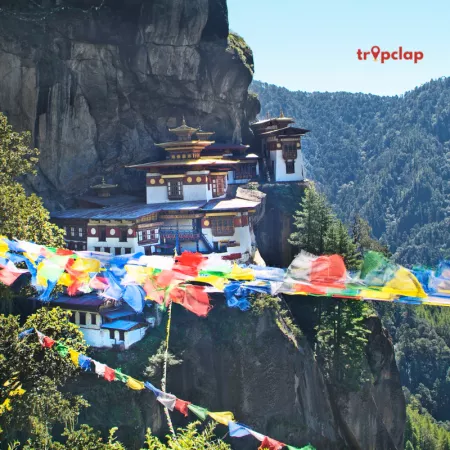Trongsa Dzong Travel Guide
Trongsa Dzong, located in central Bhutan, is a historically significant destination known for its majestic architecture and cultural importance. As the ancestral home of the royal family, Trongsa Dzong holds a special place in Bhutanese history. The town is situated on a steep ridge overlooking the Mangde Chhu River, offering breathtaking views of the surrounding valleys and mountains. Trongsa Dzong is famous for being the largest dzong fortress in Bhutan, symbolizing tradition, power, and history.Top Attractions in Trongsa Dzong
- Trongsa Dzong Fortress
- Taa Dzong Museum
- Kuenga Rabten Palace
- Gangtey Monastery
- Chendebji Chorten
Trongsa Dzong is Famous for
Its iconic Trongsa Dzong fortress, which stands as a symbol of Bhutanese heritage and tradition.Top Attractions in Trongsa Dzong
- Explore the grand Trongsa Dzong Fortress
- Visit the Taa Dzong Museum for a glimpse into Bhutanese history
- Discover the beauty of Kuenga Rabten Palace
- Experience the serenity of Gangtey Monastery
- Marvel at the ancient Chendebji Chorten
What's Great about Travelling to Trongsa Dzong?
- Experience the rich cultural heritage of Bhutan
- Enjoy stunning panoramic views of the Himalayas
- Immerse yourself in the peaceful atmosphere of the dzong
What's Not So Great about Travelling to Trongsa Dzong?
- Limited accommodation options
- Remote location with challenging terrain
- Altitude may be a challenge for some travelers
Travel Tips for Trongsa Dzong
- Obtain a Bhutanese visa before travel
- Driving is the best way to explore the region
- Respect the local customs and traditions
Important Trongsa Dzong trip information
- Ideal Duration: 2-3 days
- Best Time to Visit: Spring and Fall for pleasant weather
- Nearby Airports and Railway Stations: The nearest airport is in Paro, and the nearest railway station is in Phuntsholing
FAQ's on Trongsa Dzong
Q1: What is the best time to visit Trongsa Dzong?
The best time to visit Trongsa Dzong is during the spring months of March to May and the fall months of September to November. During these periods, the weather is pleasant, and you can enjoy clear skies and comfortable temperatures. Additionally, these months coincide with important festivals and events in Bhutan, offering a cultural experience for visitors. Avoid the monsoon season from June to August due to heavy rainfall.
Q2: Do I need a visa to travel to Trongsa Dzong?
: All tourists visiting Bhutan, including Trongsa Dzong, must obtain a visa to enter the country. Visas are processed through licensed Bhutanese tour operators who will arrange the visa clearance. There are no exceptions to this rule, and travelers must book their trip through a tour operator who will handle the visa application process. Ensure to check the latest visa requirements before planning your visit.
Q3: What are the must-visit attractions in Trongsa Dzong?
Trongsa Dzong, a significant historical site in Bhutan, is a must-visit attraction. Other notable places include Ta Dzong Museum, Chendebji Chorten, Yotong La Pass, and the Dzongkhag Museum. Nature lovers can explore the scenic beauty of the Black Mountains and the Mangde Chhu River. Don't miss the opportunity to visit local villages to experience the traditional way of life in Bhutan.
Q4: Is Trongsa Dzong a safe place to travel?
Trongsa Dzong is generally a safe place to travel with low crime rates. However, it is advisable to take normal precautions like safeguarding your belongings and being aware of your surroundings, especially in crowded areas. While the destination is safe for tourists, it's recommended to respect local customs and traditions to ensure a smooth and enjoyable visit.
Q5: What is the local currency in Trongsa Dzong and can I use credit cards?
The local currency in Bhutan is the Bhutanese Ngultrum (BTN). While credit cards are accepted at some hotels and larger establishments in major cities, it's advisable to carry cash for smaller purchases and in rural areas. ATMs are limited outside urban centers, so ensure you have enough cash when traveling to remote destinations like Trongsa Dzong.
Q6: What is the local cuisine like in Trongsa Dzong?
: Bhutanese cuisine is known for its spicy flavors and unique dishes like Ema Datshi (chili and cheese stew) and Jasha Maru (spicy chicken curry). Rice is a staple in Bhutanese meals, accompanied by vegetables, meat, and cheese. Vegetarian options are also available. Be prepared for traditional meals served with red rice and local specialties that showcase the rich culinary heritage of Bhutan.
Q7: What transportation options are available in Trongsa Dzong?
Transportation options in Trongsa Dzong include public buses, taxis, and rental cars. While public buses are economical, they may not always be frequent, especially in remote areas. Taxis are available for shorter journeys, and rental cars provide flexibility for exploring the region independently. If you prefer guided tours, consider hiring a local driver or joining organized tours to visit key attractions in and around Trongsa Dzong.
Q8: Are there any cultural norms or etiquette I should be aware of when visiting Trongsa Dzong?
Understanding and respecting local customs is essential when visiting Trongsa Dzong. Some cultural norms to observe include dressing modestly, removing shoes before entering religious sites, and seeking permission before taking photographs of people or sacred places. It's customary to greet locals with a polite "Kuzuzangpo" and show appreciation for the Bhutanese culture. Avoid public displays of affection and be mindful of local traditions to ensure a harmonious experience in Trongsa Dzong.
Q9: I am a travel agent. How can I buy travel leads of Trongsa Dzong?
Register yourself as a travel agent at agents.tripclap.com and then you can buy travel leads to Trongsa Dzong once your account is approved. For more details contact our support team at +91-8069186564 or support@tripclap.com

